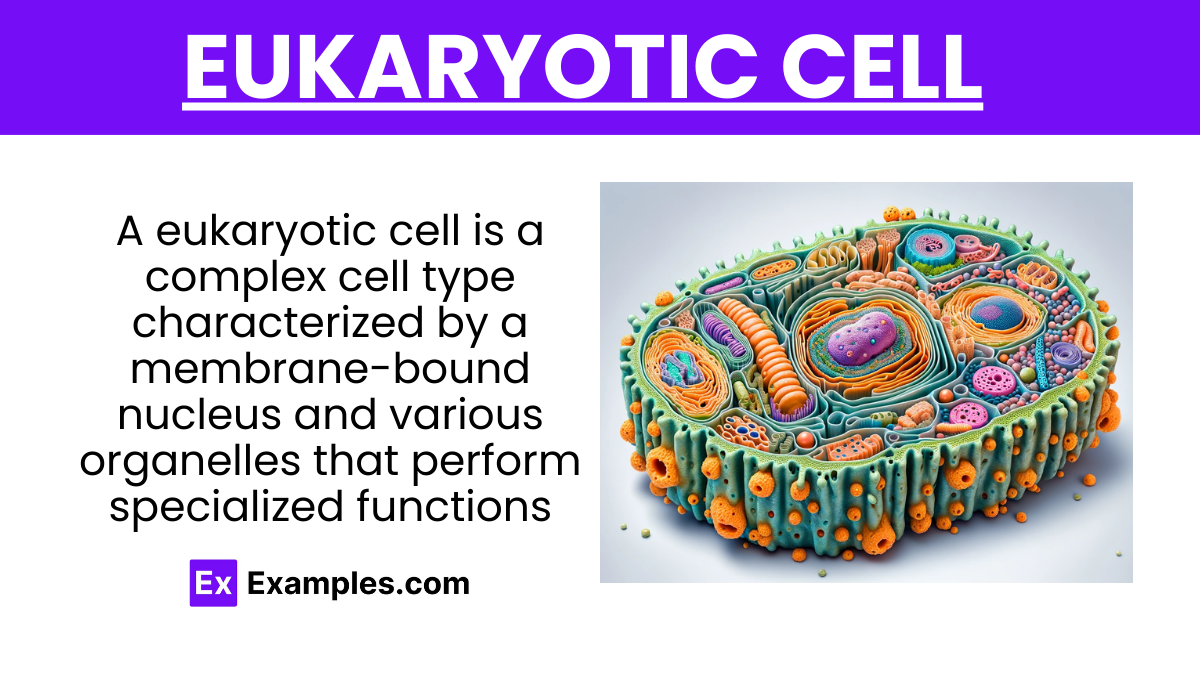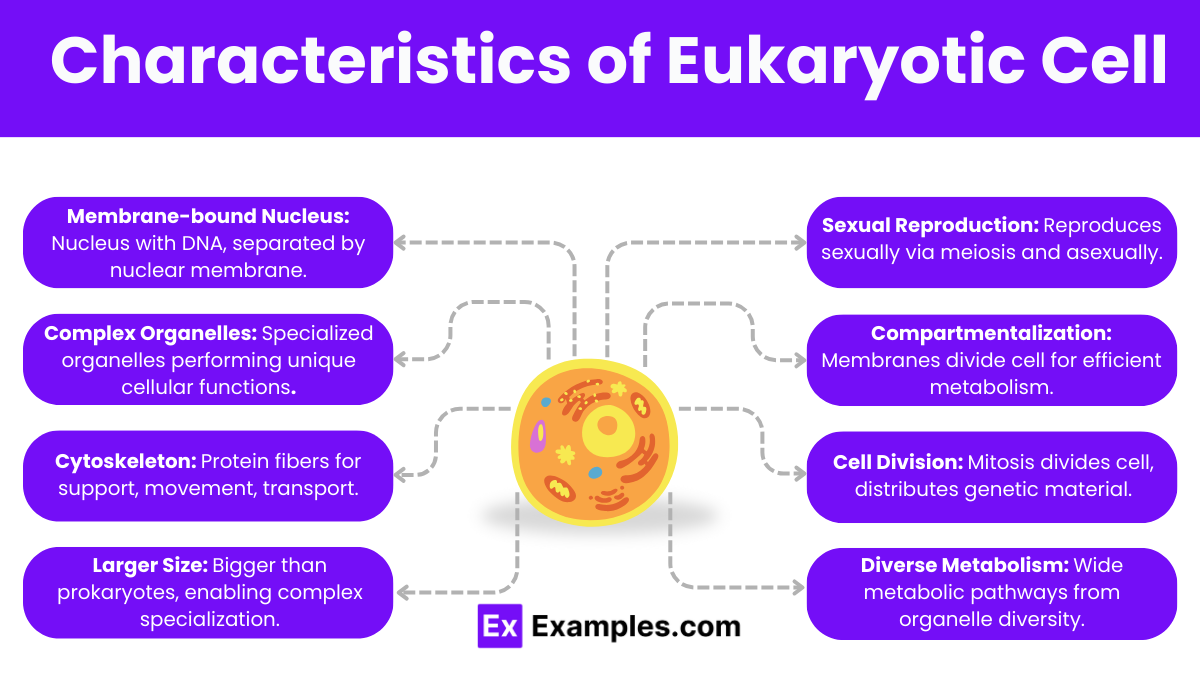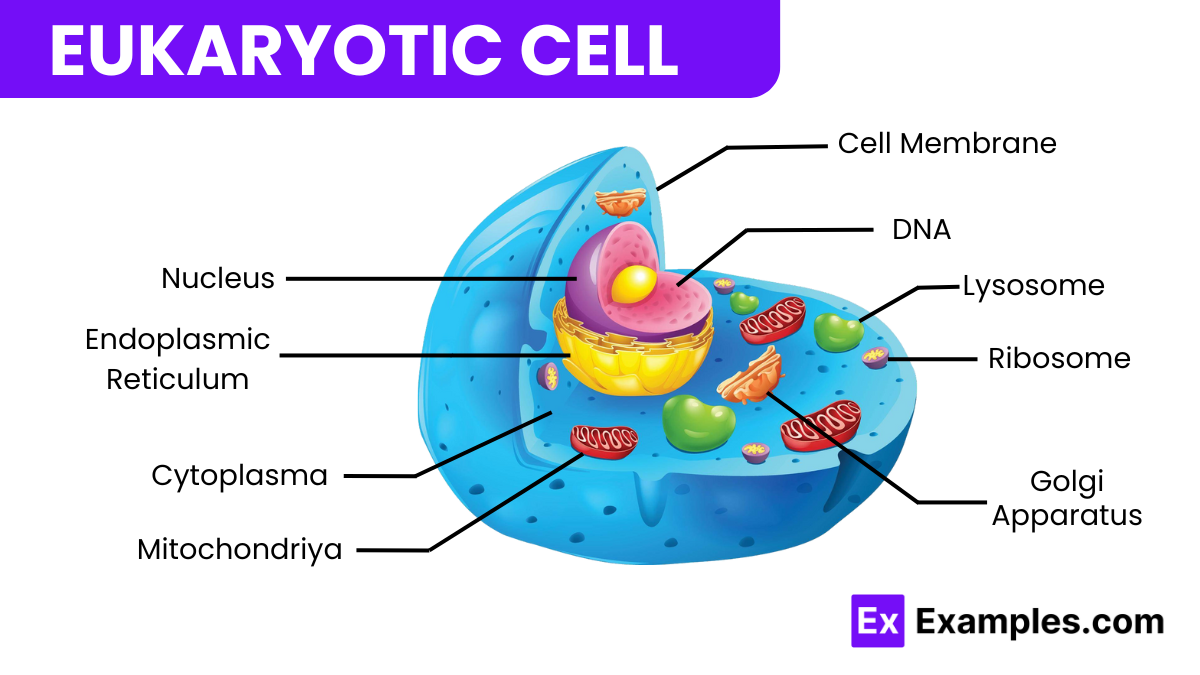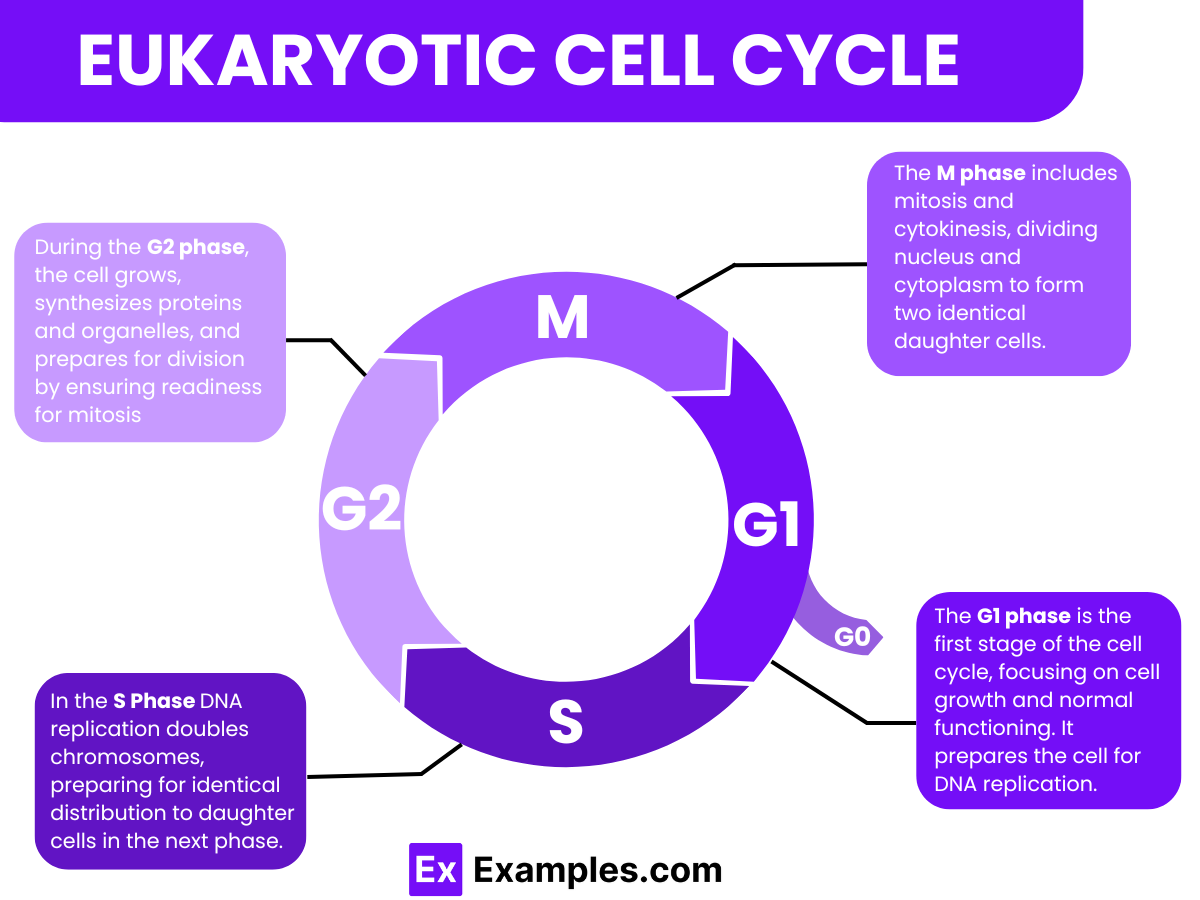Which of the following is a characteristic of eukaryotic cells?
No nucleus
DNA in a nucleoid
Membrane-bound organelles
Circular DNA

Eukaryotic cells, the sophisticated building blocks of all multicellular organisms, including humans, plants, and fungi. These cells are characterized by their well-organized structures, with a nucleus housing DNA, and various organelles performing distinct functions. From energy production in mitochondria to protein synthesis in ribosomes, eukaryotic cells orchestrate life’s processes efficiently. This guide illuminates their roles, showcasing examples like animal cells, plant cells, and the cells of yeast, highlighting their diversity and critical contributions to biodiversity and life’s intricacies.
A eukaryotic cell is a type of cell that is characterized by the presence of a nucleus enclosed within a membrane, distinguishing it fundamentally from prokaryotic cells which lack a membrane-bound nucleus. The term “eukaryotic” comes from the Greek words “eu” meaning true and “karyon” meaning nucleus, thus highlighting the cell’s defining feature. Eukaryotic cells form the foundational building blocks of eukaryotes, organisms that include animals, plants, fungi, and protists.

Eukaryotic cells are the sophisticated and complex units of life, pivotal in understanding the biological intricacies of higher organisms including plants, animals, fungi, and protists. Their unique characteristics not only distinguish them from prokaryotic cells but also underpin the vast diversity of life forms on Earth. This guide delves into the defining features of eukaryotic cells, offering insights into their structure, function, and significance in the natural world.

The eukaryotic cell, a marvel of biological complexity, is a cornerstone in the study of life sciences. Its intricate structure not only sets it apart from simpler prokaryotic cells but also enables the vast array of functions necessary for the survival and reproduction of more complex organisms. This guide provides a detailed overview of the structure of eukaryotic cells, highlighting their key components and the roles these components play in cellular life.
Nucleus: Central to the eukaryotic cell’s structure is the nucleus, often referred to as the cell’s command center. Enclosed by a double membrane known as the nuclear envelope, the nucleus houses the cell’s DNA, which is organized into chromosomes. This DNA dictates the cell’s functions and characteristics by directing protein synthesis. The nucleus contains the nucleolus, where ribosomal RNA is produced, contributing to protein assembly outside the nucleus.
Membrane-bound Organelles: Specialized Cellular Machinery
Eukaryotic cells are distinguished by their membrane-bound organelles, each serving specific functions:
Cytoskeleton: The cytoskeleton is a network of protein filaments and tubules that provides mechanical support, facilitates cell movement, and ensures the transport of materials within the cell. It is composed of microfilaments, intermediate filaments, and microtubules, each serving different structural and functional roles, from maintaining cell shape to assisting in cell division.
Cell Membrane: The cell membrane, or plasma membrane, surrounds the eukaryotic cell, acting as a selective barrier that regulates the entry and exit of substances. Composed of a lipid bilayer with embedded proteins, it is crucial for maintaining the internal environment of the cell and facilitating communication and signaling processes.
Cell Wall: Extra Protection (in Plants, Fungi, and Some Protists)While not present in animal cells, the cell wall is a key structural component in plants, fungi, and some protists. It provides additional protection and support, helping to maintain cell shape and prevent excessive water intake through osmosis.
Vacuoles: Vacuoles are large, fluid-filled organelles found in many eukaryotic cells, particularly plant cells, where they store nutrients, waste products, and contribute to cell rigidity through turgor pressure.

The eukaryotic cell cycle is a complex series of stages that a cell goes through to divide and produce two identical daughter cells. It is crucial for growth, repair, and reproduction in multicellular organisms. The cell cycle is divided into two main phases: interphase and the mitotic phase (M phase).
Interphase prepares the cell for division and is subdivided into three phases:
The mitotic phase is where the cell actually divides, and it includes two main processes:
The eukaryotic cell cycle is regulated by a complex system of proteins and enzymes that ensure cells only proceed to the next phase when they are ready, preventing errors that could lead to disease, such as cancer. This regulatory system includes checkpoints at key phases to verify that the cell is prepared for division, ensuring the integrity and faithful transmission of genetic information.
Eukaryotic cells encompass a wide range of organisms, showcasing the diversity of life. They are found in all members of the domain Eukarya, which includes the kingdoms Animalia, Plantae, Fungi, and Protista. Here are examples from each of these kingdoms to illustrate the variety of eukaryotic cells:
Human cells exhibit remarkable diversity, adapted to perform specific functions within the body. For instance, neurons transmit electrical signals across the body, enabling thought, sensation, and movement. Muscle cells are specialized for contraction, supporting movement and bodily functions. Skin cells provide a protective barrier against environmental hazards and pathogens, playing a crucial role in immunity and homeostasis.
Plant cells are unique in their ability to perform photosynthesis, thanks to chloroplasts that convert sunlight into chemical energy. They have a rigid cell wall made of cellulose, providing structural support and defining shape. Vacuoles in plant cells store nutrients and waste products and are essential for maintaining turgor pressure, which keeps plants upright.
Fungi, including yeasts and molds, have cells with a cell wall made of chitin, distinguishing them from plants. Fungal cells are adept at breaking down organic material, playing a key role in decomposition and nutrient cycling in ecosystems. Some fungi, like yeasts, are unicellular, while others form complex networks of multicellular structures.
Animal cells lack a cell wall, giving them a flexible structure that allows for a variety of shapes and functions. Blood cells, for example, include erythrocytes (red blood cells), which carry oxygen throughout the body, and leukocytes (white blood cells), which are part of the immune system. Epithelial cells cover the surfaces of the body, including the skin and the lining of internal organs, providing protection and facilitating absorption and secretion.
Protists are a diverse group of mostly unicellular organisms that do not fit neatly into the plant, animal, or fungal kingdoms. They exhibit a wide range of lifestyles, from the amoeba, which moves and feeds by extending its cell membrane, to paramecium, which uses hair-like cilia for movement and feeding. Plasmodium, the parasite that causes malaria, demonstrates the complexity of protist life cycles, involving multiple stages in both mosquito and human hosts.
Prokaryotic vs eukaryotic cells represent the two primary cell types in the biological world, differing mainly in complexity. Prokaryotic cells, found in bacteria and archaea, are simpler, lacking a nucleus and membrane-bound organelles, with their genetic material freely floating in the cytoplasm. In contrast, eukaryotic cells, which make up plants, animals, fungi, and protists, have a defined nucleus that houses their DNA and possess various specialized organelles, enabling them to carry out complex functions. These structural differences fundamentally affect their functions, reproduction, and roles in the ecosystem.
Eukaryotic cells reproduce through mitosis for growth and repair, and meiosis for producing gametes in sexually reproducing organisms, ensuring genetic diversity.
Key organelles include the nucleus, mitochondria, endoplasmic reticulum, Golgi apparatus, lysosomes, and chloroplasts (in plants), each performing vital cellular functions.
Eukaryotic cells have a defined nucleus and complex organelles, larger in size, supporting multicellularity, unlike simpler, smaller prokaryotic cells without a nucleus.
Mitochondria are the powerhouse of the cell, generating ATP through cellular respiration, supporting energy-intensive processes essential for survival and function.
Genetic material in eukaryotic cells is organized into linear chromosomes within the nucleus, protected and regulated by histones and nuclear membranes.
Eukaryotic cells are considered more complex due to their compartmentalized structure, allowing for specialized functions and processes, enabling multicellular organisms’ development.
In conclusion, eukaryotic cells are the building blocks of complex life forms, distinguished by their organized nucleus and specialized organelles. Their intricate structure enables advanced functions, from energy production to reproduction. Understanding eukaryotic cells is crucial for insights into the biological processes that underpin multicellular organisms, highlighting the marvel of cellular and organismal diversity.
Text prompt
Add Tone
Characteristics of Eukaryotic Cells
Structure of Eukaryotic Cell
Which of the following is a characteristic of eukaryotic cells?
No nucleus
DNA in a nucleoid
Membrane-bound organelles
Circular DNA
Where is the genetic material of a eukaryotic cell located?
Cytoplasm
Ribosome
Nucleus
Cell membrane
Which organelle is known as the powerhouse of the cell?
Golgi apparatus
Lysosome
Chloroplast
Mitochondrion
The rough endoplasmic reticulum (ER) is involved in:
Lipid synthesis
Protein synthesis
DNA replication
Waste detoxification
Eukaryotic cells reproduce through:
Binary fission
Mitosis and meiosis
Spore formation
Budding
Which component of the eukaryotic cell's cytoskeleton is responsible for cell movement?
Microfilaments
Intermediate filaments
Microtubules
Ribosomes
In a eukaryotic cell, the nucleolus is primarily responsible for:
DNA replication
RNA processing
Ribosome production
Protein degradation
Which organelle contains digestive enzymes and helps in breaking down cellular waste?
Endoplasmic reticulum
Lysosome
Peroxisome
Vacuole
The lipid bilayer that forms the foundation of cell membranes is primarily composed of:
Proteins
Carbohydrates
Nucleic acids
Phospholipids
In eukaryotic cells, the genetic material is organized into:
Linear chromosomes
Circular chromosomes
Plasmids
Nucleoid regions
Before you leave, take our quick quiz to enhance your learning!

